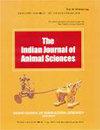印度南部喀拉拉邦Wayanad地区部落社区饲养的desi(当地)牛的表型特征
IF 0.3
4区 农林科学
Q4 AGRICULTURE, DAIRY & ANIMAL SCIENCE
引用次数: 0
摘要
本研究涉及瓦亚纳德西牛的表型特征,这是一种主要在印度南部喀拉拉邦瓦亚纳德地区的部落村庄饲养的不太为人所知的土著牛种群。利用经修改的ICAR-NBAGR指南记录了牛的生境、状况、管理、效用和性能信息以及形态学和形态计量学性状数据。Wayanad desi牛的主要繁殖地在Wayanad地区的Thavinhal、Thondernad、Ambalavayal和Noolpuzha panchayath。这些动物是在广泛的管理制度和松散的房屋制度下饲养的,在简单的kachcha房屋中饲养。它们的产奶量很低,平均日产奶量刚刚超过一升。这些动物体型很小,主要是纯棕色,前额和脸都很直。这些desi牛与喀拉拉邦其他品种的牛有几个质量和数量上的共同特征,尽管它们的地理分布不同。本文章由计算机程序翻译,如有差异,请以英文原文为准。
Phenotypic characterization of the desi (local) cattle reared by the tribal communities of Wayanad district, Kerala, South India
This study pertained to the phenotypic characterization of Wayanad desi cattle, a lesser-known indigenous cattle population reared mainly in the tribal hamlets of Wayanad district, Kerala, South India. Information on the habitat, status, management, utility and performance of the cattle and data on the morphological and morphometric traits were recorded using the ICAR-NBAGR guidelines with modifications. The main breeding tract of Wayanad desi cattle was in Thavinhal, Thondernad, Ambalavayal and Noolpuzha panchayaths of Wayanad district. These animals were reared under an extensive system of management and a loose house system in simple kachcha housing. They are low milk producers and the average daily yield was just above one litre. These animals weresmall in size, predominantly solid brown in colour, with a straight forehead and face. These desi cattle share several qualitative and quantitative features with other varieties of cattle in Kerala, eventhough their geographic distribution was different.
求助全文
通过发布文献求助,成功后即可免费获取论文全文。
去求助
来源期刊

Indian Journal of Animal Sciences
农林科学-奶制品与动物科学
CiteScore
0.60
自引率
25.00%
发文量
220
审稿时长
8 months
期刊介绍:
Articles published in The Indian Journal of Animal Sciences encompass a broad range of research topics in animal health and production related to cattle, buffalo, sheep, goat, camel, equines, pig, rabbit, yak, mithun, poultry and fisheries. Studies involving wildlife species and laboratory animal species that address fundamental questions about their biology will also be considered for publication. All manuscripts must present some new development and must be original, timely, significant and scientifically excellent. Papers will be rejected if standards of care of, or procedures performed on animals are not up to those expected of humane veterinary scientists. At a minimum, standards must meet the International Guiding Principles for Biomedical Research involving Animals, as issued by the Council for International Organizations of Medical Sciences. (C.I.O.M.S., c/o WHO, CH 1211 Geneva 27, Switzerland). Articles reporting new animal disease must follow GOI directive as given in detail in Guidelines to Authors.
 求助内容:
求助内容: 应助结果提醒方式:
应助结果提醒方式:


